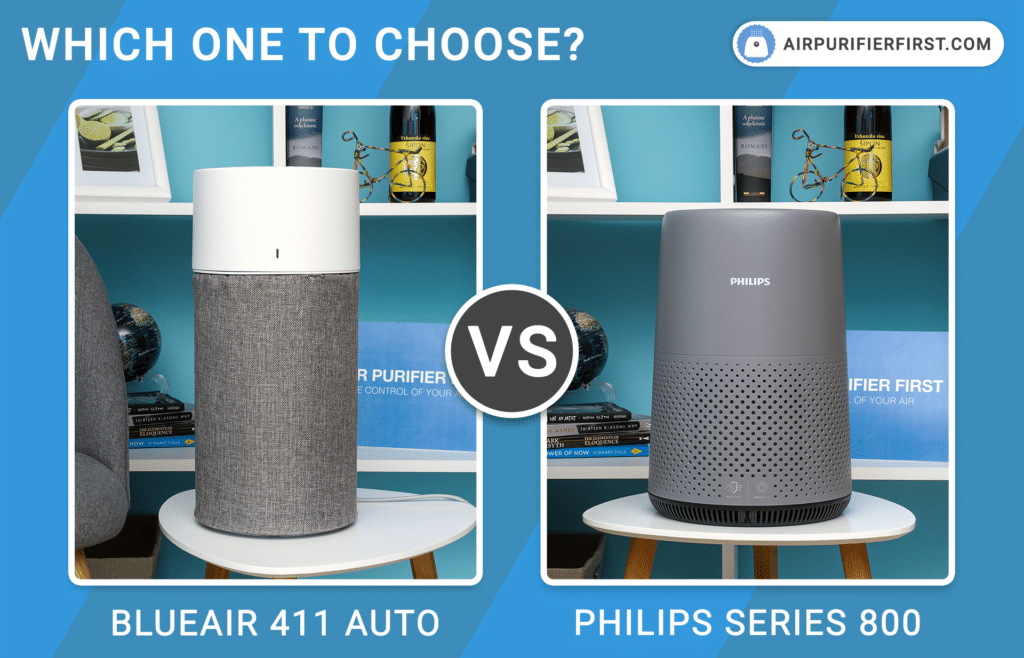Philips and Blueair are well-known air purifier brands with a global presence. In this article, I will compare two medium-sized air purifiers from these manufacturers: the Blueair 411 Auto, an updated and enhanced version of the Blueair 411, and the Philips Series 800, a unique and innovative air purifier.

There isn’t a significant difference in room coverage between these two models. The Blueair 411 Auto covers rooms up to 190 sq. ft. (18 m2), while the Philips Series 800 is suitable for rooms up to 176 sq. ft. (16 m2).
Performance test results for both purifiers are nearly identical, as are their noise levels. However, the Blueair produces a slightly clunky sound at its third speed, leading me to rate its noise levels lower than Philips’s. Regarding power consumption, the Blueair 411 Auto is more energy-efficient, but the Philips Series 800 isn’t a huge consumer as well.
Both air purifiers share features like an air quality sensor, air quality indicator, and auto mode. While they lack smart apps or other advanced features, the auto mode mentioned is a great way to automate these air purifiers.
When it comes to build quality, I have a slight preference for the Philips’s plastic and build quality, as the Blueair appears more fragile. The modern, minimalist design of both air purifiers is appealing.
Blueair Vs Philips Specifications
 |
 |
|
| Manufacturer | Blueair | Philips |
| Model | 411 Auto | Series 800 (AC0830) |
| Dimensions | 16.7 x 7.8 x 7.8 inches (42,5 x 20 x 20 cm) | 14.4 x 9.8 x 9.8 inches (36,7 x 25 x 25 cm) |
| Room Coverage (4.8 ACH) | 190 sq. ft. (18 m2) | 176 sq. ft. (16 m2) |
| Performance Ratings | ||
| Filtration Technology | Washable Pre-filter, Particle Filter, Carbon Filter, and HEPASilent | Pre-filter, NanoProtect HEPA Filter, and Activated Carbon Filter |
| Filter Replacement Indicator | Yes | Yes |
| Filter Longevity | about 6 months | up to 12 months |
| Power | 10W | 20W |
| Operating Costs Ratings | ||
| Working Modes | 3 – Night Mode, Everyday Mode, Boost Mode | 3 – Sleep Mode, Auto Mode, and Turbo Mode |
| Air Quality Sensor | Yes | Yes |
| Air Quality Indicator | Yes | Yes |
| Auto Mode | Yes | Yes |
| Noise Levels | 41.6 – 61.2 dBA | 41.8 – 62.8 dBA |
| Noise Ratings | ||
| Warranty | 2-year | 2-year |
| In-Depth Review | Blueair 411 Auto | Philips Series 800 |
| Price | Check Price on Amazon | Check Price on Amazon |
Which One Does It Better?
While the Blueair 411 Auto and Philips Series 800 share many similarities, making the comparison challenging, the Blueair 411 Auto is the winner in this comparison and my buying recommendation.
Despite the Philips Series 800 performing better in noise tests, the Blueair has slightly superior overall performance, lower maintenance costs, and a washable pre-filter.
Neither device uses a True HEPA filter. Philips features a pellet-based carbon filter, whereas Blueair features an innovative pre-filter and HEPASilent technology.
If you have any questions about these two air purifiers, don’t hesitate to leave a comment in the section below.
Leave a Reply